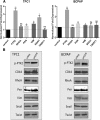Podoplanin (PDPN) affects the invasiveness of thyroid carcinoma cells by inducing ezrin, radixin and moesin (E/R/M) phosphorylation in association with matrix metalloproteinases
- PMID: 30654768
- PMCID: PMC6337816
- DOI: 10.1186/s12885-018-5239-z
Podoplanin (PDPN) affects the invasiveness of thyroid carcinoma cells by inducing ezrin, radixin and moesin (E/R/M) phosphorylation in association with matrix metalloproteinases
Abstract
Background: Podoplanin (PDPN) is a mucin-type transmembrane glycoprotein specific to the lymphatic system. PDPN expression has been found in various human tumors and is considered to be a marker of cancer. We had previously shown that PDPN expression contributes to carcinogenesis in the TPC1 papillary thyroid cancer-derived cell line by enhancing cell migration and invasiveness. The aim of this study was to determine the effect of PDPN down-regulation in another thyroid cancer-derived cell line: BcPAP.
Methods: In order to determine the effects of PDPN on malignant features of BcPAP cells (harboring the BRAFV600E mutated allele) and TPC1 cells (carrying the RET/PTC1 rearrangement), we silenced PDPN in these cells using small interfering RNA (siRNA). The efficacy of PDPN silencing was confirmed by qRT-PCR and Western blotting. Then, we tested the motility and invasiveness of these cells (using scratch test and Transwell assay), their growth capacities F(cell cycle analysis, viability, clonogenic activity) and apoptosis assays), adhesion-independent colony-formation capacities, as well as the effect of PDPN silencing on MMPs expression and activity (zymography).
Results: We found that PDPN-induced cell phenotype depended on the genetic background of thyroid tumor cells. PDPN down-regulation in BcPAP cells was negatively correlated with the migration and invasion, in contrast to TPC1 cells in which PDPN depletion resulted in enhanced migration and invasiveness. Moreover, our results suggest that in BcPAP cells, PDPN may be involved in the epithelial-mesenchymal transition (EMT) through regulating the expression of the ezrin, radixin and moesin (E/R/M) proteins, MMPs 9 and MMP2, remodeling of actin cytoskeleton and cellular protrusions. We also demonstrated that PDPN expression is associated with the MAPK signaling pathway. The inhibition of the MAPK pathway resulted in a decreased PDPN expression, increased E/R/M phosphorylation and reduced cell migration. Additionally, PDPN depleted BcPAP cells treated with inhibitors of MEK1/2 kinases (U0126) or of the BRAF V600E protein (PLX4720) had reduced motility, similar to that previously observed in TPC1 cells after PDPN knock-down.
Conclusions: Altogether, our data suggest that PDPN may play an important role in the control of invasion and migration of papillary thyroid carcinoma cells in association with the E/R/M, MMPs and MAPK kinases.
Keywords: BcPAP; Ezrin/radixin/moesin; Invasiveness; Metalloproteinases; Motility; Podoplanin; TPC1.
Conflict of interest statement
Consent for publication
Not applicable.
Competing interests
The authors declare that they have no competing interests.
Publisher’s Note
Springer Nature remains neutral with regard to jurisdictional claims in published maps and institutional affiliations.
Figures








Similar articles
-
Platelet CLEC2-Podoplanin Axis as a Promising Target for Oral Cancer Treatment.Front Immunol. 2021 Dec 15;12:807600. doi: 10.3389/fimmu.2021.807600. eCollection 2021. Front Immunol. 2021. PMID: 34987523 Free PMC article. Review.
-
The role of podoplanin in the biology of differentiated thyroid cancers.PLoS One. 2014 May 5;9(5):e96541. doi: 10.1371/journal.pone.0096541. eCollection 2014. PLoS One. 2014. PMID: 24797369 Free PMC article.
-
Resolving the role of podoplanin in the motility of papillary thyroid carcinoma-derived cells using RNA sequencing.Comput Struct Biotechnol J. 2023 Jul 26;21:3810-3826. doi: 10.1016/j.csbj.2023.07.035. eCollection 2023. Comput Struct Biotechnol J. 2023. PMID: 37560122 Free PMC article.
-
Differential effects of MAPK pathway inhibitors on migration and invasiveness of BRAF(V600E) mutant thyroid cancer cells in 2D and 3D culture.Exp Cell Res. 2015 Nov 1;338(2):127-35. doi: 10.1016/j.yexcr.2015.08.003. Epub 2015 Sep 15. Exp Cell Res. 2015. PMID: 26384551
-
Roles of Podoplanin in Malignant Progression of Tumor.Cells. 2022 Feb 7;11(3):575. doi: 10.3390/cells11030575. Cells. 2022. PMID: 35159384 Free PMC article. Review.
Cited by
-
Platelet CLEC2-Podoplanin Axis as a Promising Target for Oral Cancer Treatment.Front Immunol. 2021 Dec 15;12:807600. doi: 10.3389/fimmu.2021.807600. eCollection 2021. Front Immunol. 2021. PMID: 34987523 Free PMC article. Review.
-
Identification of Moesin (MSN) as a Potential Therapeutic Target for Colorectal Cancer via the β-Catenin-RUNX2 Axis.Int J Mol Sci. 2023 Jun 30;24(13):10951. doi: 10.3390/ijms241310951. Int J Mol Sci. 2023. PMID: 37446127 Free PMC article.
-
Podoplanin immunoexpression in odontogenic lesions: a systematic review, meta-analysis, and integrated bioinformatic analysis.Diagn Pathol. 2024 Aug 24;19(1):115. doi: 10.1186/s13000-024-01540-y. Diagn Pathol. 2024. PMID: 39182093 Free PMC article.
-
The Impact of Transcription Factor Prospero Homeobox 1 on the Regulation of Thyroid Cancer Malignancy.Int J Mol Sci. 2020 May 2;21(9):3220. doi: 10.3390/ijms21093220. Int J Mol Sci. 2020. PMID: 32370142 Free PMC article. Review.
-
Cancer-associated fibroblasts as therapeutic targets for cancer: advances, challenges, and future prospects.J Biomed Sci. 2025 Jan 9;32(1):7. doi: 10.1186/s12929-024-01099-2. J Biomed Sci. 2025. PMID: 39780187 Free PMC article. Review.
References
MeSH terms
Substances
Grants and funding
LinkOut - more resources
Full Text Sources
Medical
Molecular Biology Databases
Research Materials
Miscellaneous

